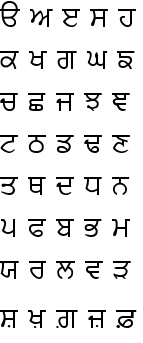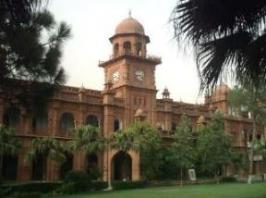Panjabi
Panjabi is the most commonly spoken language in Punjab and is the mother-tongue of the vast majority of its people.
Panjabi belongs to the Indo-Aryan language tree and appears on the Outer Band of the Indic branch. It is widely believed that Panjabi evolved from the original Vedic Sanskrit but as it developed was enriched by languages such as Persian and Arabic which have greatly influenced modern Panjabi vocabulary.
Among the modern Indo-Aryan languages of the Indic branch Panjabi is perhaps the oldest spoken language. This is likely due to the argument that Panjabi is closest to the original Vedic Sanskrit, the language of the Aryan tribes that had migrated to and colonized Punjab thousands of years ago.
Panjabi belongs to the Indo-Aryan language tree and appears on the Outer Band of the Indic branch. It is widely believed that Panjabi evolved from the original Vedic Sanskrit but as it developed was enriched by languages such as Persian and Arabic which have greatly influenced modern Panjabi vocabulary.
Among the modern Indo-Aryan languages of the Indic branch Panjabi is perhaps the oldest spoken language. This is likely due to the argument that Panjabi is closest to the original Vedic Sanskrit, the language of the Aryan tribes that had migrated to and colonized Punjab thousands of years ago.
Panjabi is distinct from the other Indic branch Indo-Aryan languages as it is tonal and consisting of three (some say four) different tones (High, Mid and Low). This is unusual among Indo-Aryan languages but common among the languages of China. The tonal feature of Panjabi therefore is perhaps a legacy that was left behind by the Kushan rule in Punjab. The Kushans are believed to have been a tribe belonging to the nomadic Yueh-Chi peoples originating from somewhere in western or central China. They established their rule over much of Punjab in two phases lasting almost 400 years from about 70 A.D until 450 A.D. It is possible that during this period Panjabi developed its distinct tonal system.
Modern Panjabi has a number of regional dialects which according to the ethnologue can be divided into the categories of Lahnda (Western Panjabi) and Eastern Panjabi. As one moves towards the centre of Punjab the chain of dialects becomes closer.
The main Panjabi dialect is known as Majhi and is spoken in the Majha region (This region includes the cities of Lahore, Sialkot, Gujaranwala, Gurdaspur and Amritsar) which is the heartland of Punjab. Most of the population of Punjab lives in this central region and Majhi is considered to be the purest and standard form of spoken Panjabi.
Modern Panjabi has a number of regional dialects which according to the ethnologue can be divided into the categories of Lahnda (Western Panjabi) and Eastern Panjabi. As one moves towards the centre of Punjab the chain of dialects becomes closer.
The main Panjabi dialect is known as Majhi and is spoken in the Majha region (This region includes the cities of Lahore, Sialkot, Gujaranwala, Gurdaspur and Amritsar) which is the heartland of Punjab. Most of the population of Punjab lives in this central region and Majhi is considered to be the purest and standard form of spoken Panjabi.
Another important dialect of Panjabi is known as Multani. Multani is spoken in certain parts of south western Punjab (Multan, Bahawalpur, Dera Ghazi Khan) and is said to differ the most from standard Panjabi. In recent years Multani has controversially been claimed to exist as a language separate from Panjabi and often is referred to as Seriaki. However, this claim is not supported by scholars and academics who maintain that Multani is a spoken dialect of Panjabi, not a separate language. The name Seriaki incidentally is a word of Sindhi origin meaning 'northern'.
Other recognized regional dialects of Panjabi include Potohari, Jhangvi, Shahpuri, Bhattiani, Doabi, Powadhi, Malwi and Kangri.
Other recognized regional dialects of Panjabi include Potohari, Jhangvi, Shahpuri, Bhattiani, Doabi, Powadhi, Malwi and Kangri.
In addition to regional dialects there exists some off-shoot languages which have developed from Panjabi. These languages are still closely related to Panjabi proper and include the following:
Hindko - Spoken in parts of Punjab's Potohar region and Pakistan's North West Frontier Province
Mirpuri - Spoken in Mirpur district of Kashmir
Dogri - Spoken in parts of Jammu & Kashmir and the Punjab Hill States (Now comprising the Indian state of Himachal Pradesh)
Hindko - Spoken in parts of Punjab's Potohar region and Pakistan's North West Frontier Province
Mirpuri - Spoken in Mirpur district of Kashmir
Dogri - Spoken in parts of Jammu & Kashmir and the Punjab Hill States (Now comprising the Indian state of Himachal Pradesh)
Another distinct feature of Panjabi is that it is written in two different scripts, Gurmukhi and Shahmukhi.
Since the division of Punjab in 1947 the Gurmukhi script is now most commonly used in East Punjab for writing Panjabi. Gurmukhi script was developed in the 16th century C.E. from an older Panjabi script called Landa. The template of the script was introduced by Guru Nanak and later finalized by the second Sikh Guru, Guru Angad. Gurmukhi is a modified and updated version of the Landa script developed to better represent spoken Panjabi. It was originally created in order to compose the hymns and sacred writings of the Sikhs but later became used for general purposes for writing Panjabi.
Shahmukhi is a slightly modified Persian script used for writing Panjabi in the Nastaliq style and is now primarily used in the West Punjab. The term 'Shahmukhi' is relatively recent but the script itself is very old and predates Gurmukhi by many centuries. The first time Panjabi was popularized in Persian script is believed to have been by Sufi saint, Farid-ul-Din Masaud Shakarganj of Pak Pattan (Known affectionately as Baba Farid to Punjabis) in the 12th century C.E. Shahmukhi is written from right-to-left like all other Arabic derived scripts (Unlike Gurmukhi which is written from left-to-right).
The old Landa script was still in use up until the early part of the 20th century by many traders in Punjab but this script has seen its last days and is now almost completely out of use.
Since the division of Punjab in 1947 the Gurmukhi script is now most commonly used in East Punjab for writing Panjabi. Gurmukhi script was developed in the 16th century C.E. from an older Panjabi script called Landa. The template of the script was introduced by Guru Nanak and later finalized by the second Sikh Guru, Guru Angad. Gurmukhi is a modified and updated version of the Landa script developed to better represent spoken Panjabi. It was originally created in order to compose the hymns and sacred writings of the Sikhs but later became used for general purposes for writing Panjabi.
Shahmukhi is a slightly modified Persian script used for writing Panjabi in the Nastaliq style and is now primarily used in the West Punjab. The term 'Shahmukhi' is relatively recent but the script itself is very old and predates Gurmukhi by many centuries. The first time Panjabi was popularized in Persian script is believed to have been by Sufi saint, Farid-ul-Din Masaud Shakarganj of Pak Pattan (Known affectionately as Baba Farid to Punjabis) in the 12th century C.E. Shahmukhi is written from right-to-left like all other Arabic derived scripts (Unlike Gurmukhi which is written from left-to-right).
| The Gurmukhi alphabet consists of 40 letters in addition to some extra vowel and other sound modifying characters. Gurmukhi is written from left-to-right. | The Shahmukhi alphabet consists of 37 letters along with an extra set characters for clarifying sounds. Shahmukhi is written from right-to-left. |
| The Gurmukhi script: | The Shahmuhki script: |
 |  |
There is no verifiable data on the actual number of Panjabi speakers in the World but common estimates suggest that there are close to 100 million
speakers, perhaps even more. The large majority of these live in the Punjab itself, with the greatest number being in the Punjab province of Pakistan (West Punjab). Although Panjabi is a language with a rich oral, musical and literary tradition spanning many centuries tragically it has suffered apathy from amongst its own ruling class and elite and has rarely in its history enjoyed state patronage or promotion.
 Despite being the mother-tongue of the masses Panjabi has no official status in the Punjab province of Pakistan and is not taught at school level nor is it used as the medium of instruction in West Punjab schools. In East Punjab too Panjabi has suffered step-motherly treatment and it is only with stern agitation from the Sikh community that Panjabi became the official language of the Punjab state (India) in 1966. Though at great cost to the territorial integrity of the East Punjab which was subsequently divided into 3 states and 1 union territory. Two out of three of these new states that were carved out of the East Punjab (Haryana and Himachal Pradesh) opted for Hindi as their official languages, leaving Panjabi to neglect.
Despite being the mother-tongue of the masses Panjabi has no official status in the Punjab province of Pakistan and is not taught at school level nor is it used as the medium of instruction in West Punjab schools. In East Punjab too Panjabi has suffered step-motherly treatment and it is only with stern agitation from the Sikh community that Panjabi became the official language of the Punjab state (India) in 1966. Though at great cost to the territorial integrity of the East Punjab which was subsequently divided into 3 states and 1 union territory. Two out of three of these new states that were carved out of the East Punjab (Haryana and Himachal Pradesh) opted for Hindi as their official languages, leaving Panjabi to neglect.
 Despite being the mother-tongue of the masses Panjabi has no official status in the Punjab province of Pakistan and is not taught at school level nor is it used as the medium of instruction in West Punjab schools. In East Punjab too Panjabi has suffered step-motherly treatment and it is only with stern agitation from the Sikh community that Panjabi became the official language of the Punjab state (India) in 1966. Though at great cost to the territorial integrity of the East Punjab which was subsequently divided into 3 states and 1 union territory. Two out of three of these new states that were carved out of the East Punjab (Haryana and Himachal Pradesh) opted for Hindi as their official languages, leaving Panjabi to neglect.
Despite being the mother-tongue of the masses Panjabi has no official status in the Punjab province of Pakistan and is not taught at school level nor is it used as the medium of instruction in West Punjab schools. In East Punjab too Panjabi has suffered step-motherly treatment and it is only with stern agitation from the Sikh community that Panjabi became the official language of the Punjab state (India) in 1966. Though at great cost to the territorial integrity of the East Punjab which was subsequently divided into 3 states and 1 union territory. Two out of three of these new states that were carved out of the East Punjab (Haryana and Himachal Pradesh) opted for Hindi as their official languages, leaving Panjabi to neglect.Guru Angad, the 2nd Sikh Guru and creator of the Gurmukhi
script (1504-1552)


